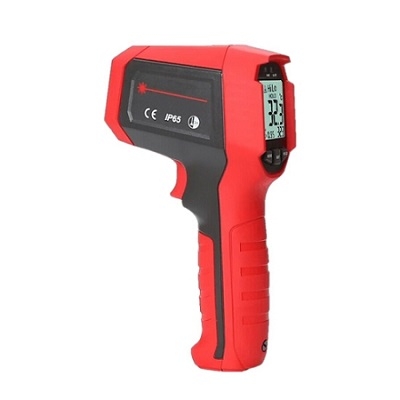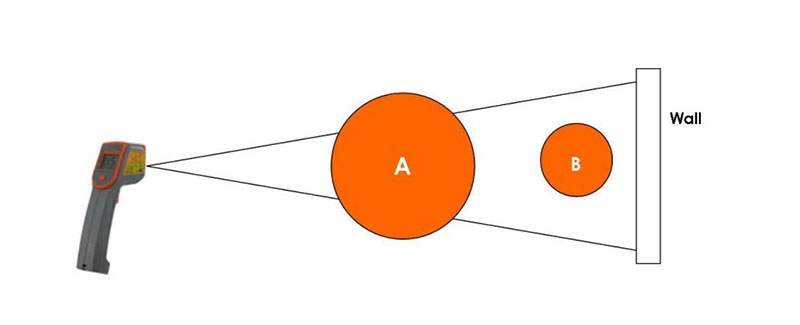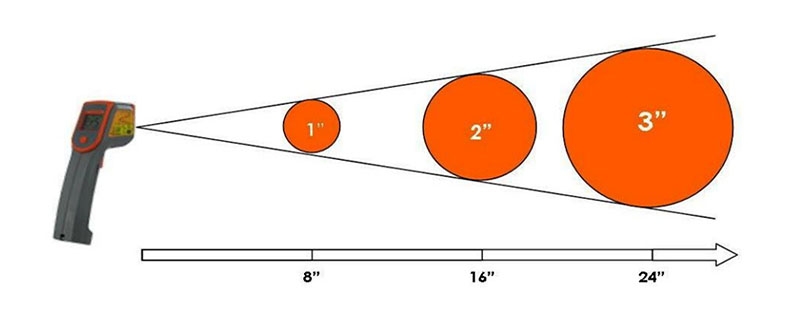All objects give off heat in the form of infrared radiation (IR). IR thermometers measure the IR emitted by an object to determine the temperature of the object. They are sometimes called laser thermometers if a laser is used to help aim the thermometer, or non-contact thermometers or temperature guns, to describe the device's ability to measure temperature from a distance. SISCO online shop will introduce the basic information about the infrared thermometer for you.
Examples of Use
IR thermometers can be used to serve a wide variety of temperature monitoring functions. A few examples include:
- Checking for hot spots in fire-fighting.
- Checking mechanical or electrical equipment for temperature and hot spots.
- Checking heater or oven temperature, for calibration and control.
- Monitoring materials in processes involving heating or cooling.
How to Determine which IR Thermometer to Purchase
Several key features should be compared when looking to purchase an IR thermometer:
- Temperature Range you anticipate to encounter.
- Type of Surface Being Measured.
- Accuracy of instruments.
- Target size and Distance from Target.
Temperature Range- It is important to give some thought to the intended range of temperature you are likely to measure with your IR thermometer. Choose a thermometer with a specified range that most narrowly covers what you are planning to measure.
Type of Surface Being Measured- Different surface types emit different amounts of infrared energy. Emissivity is the measure of an object's ability to emit infrared energy. Emitted energy indicates the temperature of the object. Emissivity can have a value from 0 (e.g., a shiny surface, such as a mirror) to 1.0 (blackbody). Most organic, painted, or oxidized surfaces have emissivity values close to 0.95.
Some infrared thermometers have a fixed emissivity setting (usually of 0.95 or 0.97) that attempts to simplify their operation while leaving them suitable for most material surfaces. Other infrared thermometers come with adjustable emissivity settings, so you can more accurately prepare your thermometer for the type of surface being measured.
Accuracy- Accuracy depends on the temperature of whatever you're measuring - typically the accuracy gets worse at very high or very low temperatures. Quoted accuracy figures often refer to the accuracy within a specific temperature range (not across the entire temperature range covered), so take care when comparing the specs of different models. Also remember that, just because the screen displays the temperature to the nearest 0.1 degrees, that doesn't mean that the reading is accurate to within 0.1 degrees.
Target Size and Distance from Target
Field of View- Target size and distance are also critical to accuracy for most IR thermometers. Every IR instrument has a field of view (FOV), an angle of vision in which it will average all the temperatures it sees.
Object A fills the field of view of the thermometer; the only temperature seen is that of object A, so the temperature of object A will be accurately indicated. But if object A is removed, object B and the wall share the field of view. The indicated temperature will be somewhere between that of object B and the wall, depending on the relative areas of each filling the circular field of view.

Distance to Spot Ratio- Field of view is often described by a distance-to-spot ratio (D:S). The optical system of an infrared thermometer collects the infrared energy from a circular measurement spot and focuses it on the detector. Optical resolution is defined by the ratio of the distance from the instrument to the object compared to the size of the spot being measured. This is called the Distance to Spot (D:S) ratio. The larger the ratio number, the better the instrument's resolution and the smaller the spot size that can be measured. The laser sighting included in some instruments only helps to aim at the measured spot.
The Distance to Spot ratio [D:S] is the size of the area (“spot”) being measured as it relates to the distance of the thermometer from the spot. For example, a D:S ratio of 8 to 1, would measure a 1-inch spot at a distance of 8 inches. In terms of field of view, if the distance to the object divided by the diameter of the object is exactly 8, then the object exactly fills the instrument’s field of view. As the distance increases, the size of the spot measured would increase. So at 16 inches,
the spot being measured would be 2 inches wide; at 24”, it would be 3” wide.

The D:S ratio impacts the accuracy of the reading. If the target you are measuring is 6 inches in size, and your infrared thermometer has a D:S ratio of 8:1, then the maximum distance you can reliably measure the temperature of the target is 48 inches. Beyond this distance, the size of the spot being measured increases and not only is the target being measured, but whatever else falls within the "spot" (or field of view) is being measured as well. This means that if a very hot object is the target, and it is in cooler surroundings, then measurements taken beyond the maximum distance will include cooler elements and lower the average temperature of what is in the "spot".
Make sure that the target is larger than the spot size the unit is measuring. The smaller the target, the closer you should be to it. When accuracy is critical, make sure that the target is at least twice as large as the spot size.
So, How Do You Know What D:S Ratio You Need?
Using this relationship between D:S ratio, size of the target spot, and measure distance, you can determine if an IR thermometer meets your needs or, conversely, which IR thermometer you need:
1. If you know your target size and the D:S ratio of the IR thermometer, you can tell how far away you can be from the target and still get an accurate measurement by using the following formula:
D:S Ratio x Target Size=maximum Measure Distance
8:1 x 6 inches=48 inches
2. If you know how far away from the target you will be, and the size of the target spot, you can determine the minimum D:S ratio required as follows:
Measure Distance/Target Size=minimum D:S ratio required
48 inches / 6 inches=8 [or 8:1]
3. If you know your distance from the target and the D:S ratio of the IR thermometer, you can tell the smallest target size that can be measured accurately by using the formula:
Measure Distance/D:S ratio=minimum target size for accurate measurement
48 inches / 8=6 inches
As the target size decreases, or the distance to the target increases, a larger D/S Ratio becomes necessary. We can see this using example 2 above: let’s first decrease the target size to 2 inches:
48 inches / 2 inches = 24:1 required D:S ratio
Now let’s go back to the original target size of 6 inches, but increase the measure distance to 60:
60 inches / 6 inches = 10:1 required D:S ratio
D:S Ratios vary greatly, so carefully compare this feature of IR thermometers when selecting the best IR thermometer to meet your needs. SISCO store can provide you with a choice of high quality, high accuracy IR thermometers, whatever your question, we are here 24 hours a day to help you, welcome to visit us.

